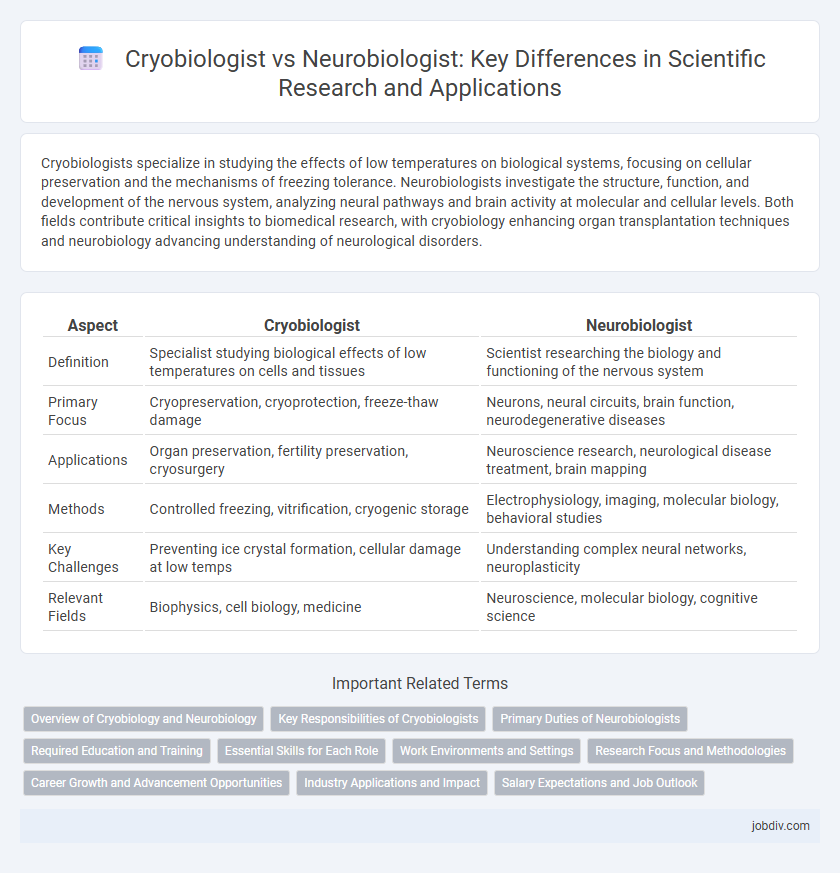Cryobiologists specialize in studying the effects of low temperatures on biological systems, focusing on cellular preservation and the mechanisms of freezing tolerance. Neurobiologists investigate the structure, function, and development of the nervous system, analyzing neural pathways and brain activity at molecular and cellular levels. Both fields contribute critical insights to biomedical research, with cryobiology enhancing organ transplantation techniques and neurobiology advancing understanding of neurological disorders.
Table of Comparison
| Aspect | Cryobiologist | Neurobiologist |
|---|---|---|
| Definition | Specialist studying biological effects of low temperatures on cells and tissues | Scientist researching the biology and functioning of the nervous system |
| Primary Focus | Cryopreservation, cryoprotection, freeze-thaw damage | Neurons, neural circuits, brain function, neurodegenerative diseases |
| Applications | Organ preservation, fertility preservation, cryosurgery | Neuroscience research, neurological disease treatment, brain mapping |
| Methods | Controlled freezing, vitrification, cryogenic storage | Electrophysiology, imaging, molecular biology, behavioral studies |
| Key Challenges | Preventing ice crystal formation, cellular damage at low temps | Understanding complex neural networks, neuroplasticity |
| Relevant Fields | Biophysics, cell biology, medicine | Neuroscience, molecular biology, cognitive science |
Overview of Cryobiology and Neurobiology
Cryobiology studies the effects of low temperatures on biological systems, focusing on cellular preservation, cryopreservation techniques, and the mechanisms of freezing and thawing in tissues. Neurobiology investigates the structure and function of the nervous system, emphasizing neural development, neurophysiology, and synaptic signaling pathways. Both fields contribute to medical advances, with cryobiology enabling organ preservation for transplantation and neurobiology enhancing understanding of neurological diseases and brain function.
Key Responsibilities of Cryobiologists
Cryobiologists specialize in studying the effects of low temperatures on biological systems, focusing on the preservation of cells, tissues, and organs through cryopreservation techniques. Their key responsibilities include optimizing freezing and thawing protocols to minimize cellular damage, investigating cryoprotectants to enhance viability, and developing methods for long-term storage of biological samples. This expertise contrasts with neurobiologists, who primarily study the nervous system's structure, function, and disorders.
Primary Duties of Neurobiologists
Neurobiologists primarily investigate the structure, function, and development of the nervous system, analyzing neural circuits and brain activity through experimental and computational methods. Their duties include conducting research on neuron behavior, synaptic transmission, and neuroplasticity to understand neurological disorders and cognitive processes. Neurobiologists often collaborate with clinicians to develop targeted treatments for diseases such as Alzheimer's, Parkinson's, and multiple sclerosis.
Required Education and Training
Cryobiologists typically require advanced degrees in biology, biochemistry, or related fields, often pursuing a Ph.D. with specialized research in low-temperature biology and preservation techniques. Neurobiologists must obtain a strong foundation in neuroscience, biology, or psychology, frequently completing doctoral studies emphasizing neural systems and brain function. Both fields demand rigorous laboratory experience and proficiency in experimental methodologies specific to their disciplines for successful careers.
Essential Skills for Each Role
Cryobiologists require expertise in low-temperature biology, proficiency with cryopreservation techniques, and a strong understanding of cellular responses to freezing conditions. Neurobiologists must possess skills in neuroanatomy, electrophysiology, and advanced microscopic imaging to analyze neural circuitry and brain function. Both roles demand rigorous data analysis capabilities and a solid foundation in molecular biology methods to support experimental design and interpretation.
Work Environments and Settings
Cryobiologists primarily conduct research in laboratory settings equipped with advanced temperature-controlled chambers and cryopreservation facilities, focusing on the effects of low temperatures on biological systems. Neurobiologists often work in diverse environments including neuroscience labs, hospitals, and imaging centers, utilizing electrophysiology equipment and brain imaging technologies to study nervous system function and disorders. Both professions commonly collaborate within academic institutions and research centers, but their specialized equipment and specific study conditions diverge according to their distinct scientific domains.
Research Focus and Methodologies
Cryobiologists study the effects of low temperatures on biological systems, employing techniques such as cryopreservation and vitrification to preserve cells, tissues, and organs. Neurobiologists focus on the structure and function of the nervous system, utilizing methods like electrophysiology, neuroimaging, and molecular biology to investigate neural processes. Both fields integrate interdisciplinary approaches, but cryobiology emphasizes temperature manipulation, while neurobiology centers on neural activity and connectivity.
Career Growth and Advancement Opportunities
Cryobiologists experience career growth through specialized research in freezing and preservation techniques, often advancing in biotechnology and medical fields focused on organ preservation and cryopreservation technologies. Neurobiologists encounter diverse advancement opportunities within academic, pharmaceutical, and clinical research settings, focusing on brain function, neurological disorders, and neurodegenerative disease treatments. Both fields demand continuous learning and offer prospects for leadership roles in interdisciplinary projects and innovation-driven environments.
Industry Applications and Impact
Cryobiologists specialize in the preservation of cells, tissues, and organs at ultra-low temperatures, enabling advancements in organ transplantation, biobanking, and reproductive technologies. Neurobiologists focus on understanding the nervous system's functionality, driving innovations in neurodegenerative disease treatments, brain-computer interfaces, and cognitive enhancement therapies. Both fields significantly impact biotechnology and healthcare industries by providing critical insights and technologies that improve patient outcomes and enable new therapeutic approaches.
Salary Expectations and Job Outlook
Cryobiologists typically earn an average salary ranging from $70,000 to $110,000 annually, reflecting the specialized nature of preserving biological samples at low temperatures, while neurobiologists' salaries average between $75,000 and $120,000, driven by their research in brain function and neurological disorders. Job outlook for cryobiologists is steady, with growth linked to advances in medical preservation technologies and biobanking, whereas neurobiologists face strong demand due to expanding research in neurodegenerative diseases and brain-computer interfaces. Both fields offer robust opportunities, but neurobiology presents broader application scopes, often leading to higher long-term salary potential and job market expansion.
Cryobiologist vs Neurobiologist Infographic

 jobdiv.com
jobdiv.com